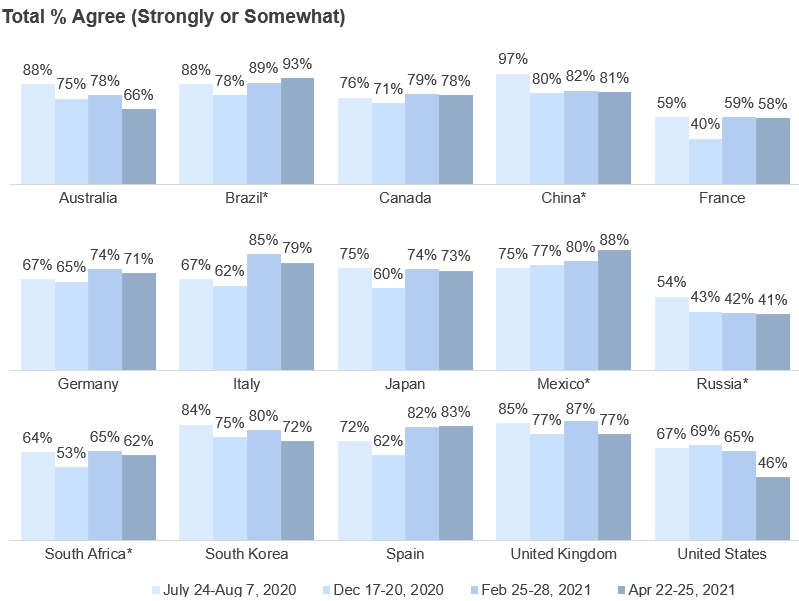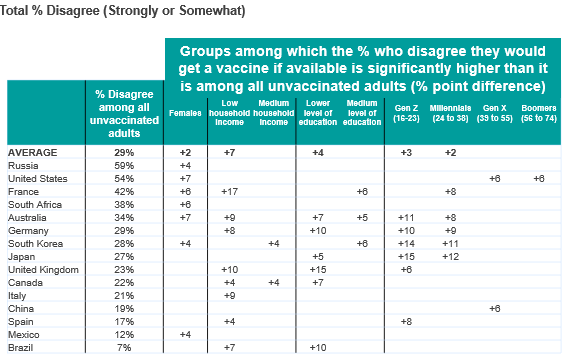Majorities of unvaccinated adults in most of 15 countries would get a vaccine if they could
New York, NY, May 25, 2021 — A new Ipsos survey of nearly 10,000 unvaccinated adults in 15 countries conducted in partnership with the World Economic Forum finds that vaccine hesitancy tends to be more prevalent among those with lower incomes or lower levels of education, younger generations and/or females. Majorities in all but two of the countries surveyed intend to get a COVID-19 vaccine when it will be available to them. However, the study indicates that vaccination intent has been declining since February – not only in the United States and the United Kingdom where about half of all adults have already received at least one dose, but also in countries, where fewer vaccination campaigns have been much slower, such as Australia and South Korea.
The survey was conducted among 9,890 unvaccinated adults under the age of 75, April 22-25, 2021, on Ipsos’ Global Advisor online platform.
Read the World Economic Forum's article.
Vaccination intent among the unvaccinated by country
Among adults who have not yet been vaccinated against COVID-19, those who strongly or somewhat agree they would get it make up a majority of those who report they have not yet received it in 13 of the 15 countries surveyed. Intent to get vaccinated among those who are not is:
- Very high in Brazil (93%), Mexico (88%), Spain (83%), and China (81%);
- Fairly high in Italy (79%), Canada (78%), Japan (73%), South Korea (72%), and Germany (71%);
- Middling in Australia (66%), South Africa (62%), and France (58%); and,
- Low in United States (46%) and Russia (41%)
While the percentage of unvaccinated adults who strongly or somewhat agree they would get a COVID-19 vaccine has not changed significantly since February in eight of the 15 countries, it has increased by more than 3 points in Mexico (+8) and Brazil (+4) and it has dropped by more than 3 points in the United States (-19), Australia (-12), the United Kingdom (-10), South Korea (-8), and Italy (-6).
To put these numbers in perspective, according to Oxford University data, the share of the population who had been given at least one dose of the vaccine at the time of the survey was: approximately 50% in the U.K; 41% in the U.S, 29% in Canada, 23% in Germany, 22% in Spain, 21% in France and Italy, 13% in Brazil, 9% in Mexico, 8% in Russia, 4% in South Korea, 1% in Japan and Australia, and less than 1% in South Africa.

Profiling the vaccine hesitant
On average, among all adults surveyed across the 15 countries, 29% disagree they would get a vaccine for COVID-19 if it were available to them. Ipsos found that a higher percentage among:
- Those with a lower household income (by 7 points);
- Those with a lower level of education (by 4 points);
- Those aged 16-23 a.k.a. Gen Z (by 3 points) and those aged 24 to 38 a.k.a. Millennials (2 points); and
- Females (2 points)
The following demographic groups are significantly more likely to disagree in various countries:
- Those in the lower income group in France (17 points), the U.K. (10 points), Australia and Italy (9 points), Germany (8 points), Brazil (7 points), and Canada and Spain (4 points); and in the medium income group in South Korea and Canada (4 points);
- Those with a lower level of education in the U.K. (15 points), Brazil and Germany (10 points), Australia and Canada (7 points), and Japan (5 points); and with a medium level education in France and South Korea (6 points) and Australia (5 points);
- Gen Z members in Japan (15 points), South Korea (14 points), Australia (11 points), Germany (10 points), Spain (8 points), and the U.K. (6 points); Millennials in Japan (12 points) , South Korea (11 points), Germany (9 points), Australia and France (8 points)
- In contrast, Gen X members (aged 39 to 55) in China and the U.S. (by 6 points in both); and Boomers (aged 55 to 74) only in the U.S. (by 6 points);
- Women in Australia, the U.S. (7 points above average in both countries), France and South Africa (6 points), as well as Mexico, Russia and South Korea (4 points);

About the Study
The survey was conducted by Ipsos on its Global Advisor online platform, April 22-25, 2021, among 9,890 unvaccinated adults 18-74 years of age in Canada, South Africa, and the United States, and 16-74 in Australia, Brazil, China (mainland), France, Germany, Italy, Japan, Mexico, Russia, South Korea, Spain, and the United Kingdom.
The samples in Australia, Canada, France, Germany, Italy, Japan, South Korea, Spain, the U.K., and the U.S. can be taken as representative of unvaccinated adults among the general adult population in these countries under the age of 75. The samples in Brazil, China (mainland), Mexico, Russia, and South Africa are more urban, more educated, and/or more affluent than the general population. The survey results for these countries should be viewed as reflecting the views of unvaccinated adults among the more “connected” segment of the population.
The sample size is 870 in Australia, 856 in Brazil, 630 in Canada, 455 in China, 701 in France, 746 in Germany, 799 in Italy, 976 in Japan, 435 in Mexico, 419 in Russia, 470 in South Africa, 941 in South Korea, 826 in Spain, 398 in the U.K., and 368 in the U.S..
This document includes comparisons with data from a similar survey conducted on the Ipsos Global Advisor platform, February 25-28, 2021, December 17-20, 2020, and July 24-August 7, 2020.
The data is weighted so that each country’s sample composition best reflects the demographic profile of the adult population according to the most recent census data.
Where results do not sum to 100 or the ‘difference’ appears to be +/-1 more/less than the actual, this may be due to rounding, multiple responses, or the exclusion of “don't know” or not stated responses.
The precision of Ipsos online polls is calculated using a credibility interval with a poll of N=1,000 accurate to +/-3.5 percentage points. For more information on Ipsos’ use of credibility intervals, please visit the Ipsos website.
The publication of these findings abides by local rules and regulations.
